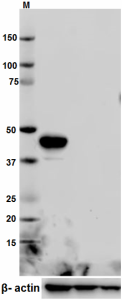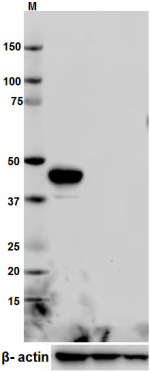- Clone
- W15137A (See other available formats)
- Regulatory Status
- RUO
- Other Names
- TNF receptor associated factor 1, EBI6
- Isotype
- Mouse IgG1, κ
- Ave. Rating
- Submit a Review
- Product Citations
- publications

-

Total cell lysates (15 µg protein) from Raji (lane 1), Daudi (lane 2) and 293E (lane 3) were resolved by electrophoresis (4-12% Bis-Tris gel), transferred to nitrocellulose, and probed with 1 µg/mL (1:500 dilution) of purified anti-TRAF1 antibody, clone W15137A (upper panel). Proteins were visualized by chemiluminescence detection (Cat. No. 426303) using a 1:3000 diluted anti-mouse-IgG secondary antibody conjugated to HRP for anti-TRAF1 antibody or 1:5000 diluted Direct-Blot HRP anti-β-Actin antibody, clone 2F1-1 (lower panel). Lane M: Molecular weight ladder.
| Cat # | Size | Price | Quantity Check Availability | Save | ||
|---|---|---|---|---|---|---|
| 689802 | 100 µg | 203€ | ||||
TNF Receptor Associated Factor 1 (TRAF1) is a member of the TRAF protein family, which mediates the downstream signaling of the TNFR superfamily, such as CD40, CD30, TNFR1 and TNFR2. Upon stimulation of TNF-α, TRAF1 forms a heterodimer with TRAF2 and subsequently activates MAPK/JNK and NFkB pathways. The TRAF1/TRAF2 complex also interacts with apoptosis inhibitor protein IAPs and mediates the anti-apoptotic signaling from TNF receptor. This heterodimer is part of the antiapoptotic E3 ubiquitin-protein ligase complex which promotes ubiquitination of target proteins, such as MAP3K14. TRAF proteins function as adaptor proteins for many cell surface receptors and participate in cell survival, proliferation and differentiation. Defects in TRAF1 have been shown to associate with hodgkin lymphoma and rheumatoid arthritis.
Product DetailsProduct Details
- Verified Reactivity
- Human
- Antibody Type
- Monoclonal
- Host Species
- Mouse
- Immunogen
- Partial human TRAF1 recombinant protein (1-182 a.a.) expressed in E. coli.
- Formulation
- Phosphate-buffered solution, pH 7.2, containing 0.09% sodium azide.
- Preparation
- The antibody was purified by affinity chromatography.
- Concentration
- 0.5 mg/ml
- Storage & Handling
- The antibody solution should be stored undiluted between 2°C and 8°C.
- Application
-
WB - Quality tested
- Recommended Usage
-
Each lot of this antibody is quality control tested by Western blotting. For Western blotting, the suggested use of this reagent is 0.5 - 2.0 µg per ml. It is recommended that the reagent be titrated for optimal performance for each application.
- RRID
-
AB_2629790 (BioLegend Cat. No. 689802)
Antigen Details
- Structure
- 416 amino acids with a predicted molecular weight of 46 kD. Contains a C-terminal MATH/TRAF domain responsible for binding to receptor cytoplasmic domains.
- Distribution
-
Cytoplasm.
- Function
- TRAF1 is an adaptor protein, mediating downstream signaling of the TNFR superfamily. It plays a role in the regulation of cell survival, proliferation, and differentiation.
- Interaction
- TRAF1 forms a homotrimer and a heterodimer with TRAF2. Interacts with TRAIP, TANK, RIPK2, BIRC2, IRC3, NFATC2IP, TRAFD1, HIVEP3, MAP3K14, and TNFR family members.
- Biology Area
- Cell Biology, Signal Transduction
- Antigen References
-
1. Kim CM, et al. 2016. Sci. Rep. 6:25526.
2. Greenfeld H, et al. 2015. PLoS Pathog. 11:e1004890.
3. Lu YY, et al. 2013. Nat. Commun. 4:2852.
4. McPherson AJ, et al. 2012. J. Biol. Chem. 287:23010.
5. Wang C, et al. 2012. J. Exp. Med. 209:77.
6. Lee SY, et al. 2007. Adv. Exp. Med. Biol. 597:25. - Gene ID
- 7185 View all products for this Gene ID
- UniProt
- View information about TRAF1 on UniProt.org
Related FAQs
Other Formats
View All TRAF1 Reagents Request Custom Conjugation| Description | Clone | Applications |
|---|---|---|
| Purified anti-TRAF1 | W15137A | WB |
Compare Data Across All Formats
This data display is provided for general comparisons between formats.
Your actual data may vary due to variations in samples, target cells, instruments and their settings, staining conditions, and other factors.
If you need assistance with selecting the best format contact our expert technical support team.
-
Purified anti-TRAF1

Total cell lysates (15 µg protein) from Raji (lane 1), Daudi...

 Login / Register
Login / Register 







Follow Us